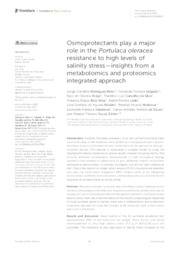Osmoprotectants play a major role in the Portulaca oleracea resistance to high levels of salinity stress-insights from a metabolomics and proteomics integrated approach.
Osmoprotectants play a major role in the Portulaca oleracea resistance to high levels of salinity stress-insights from a metabolomics and proteomics integrated approach.
Author(s): RODRIGUES NETO, J. C.; SALGADO, F. F.; BRAGA, I. DE O.; SILVA, T. L. C. DA; SILVA, V. N. B.; LEAO, A. P.; RIBEIRO, J. A. de A.; ABDELNUR, P. V.; VALADARES, L. F.; SOUSA, C. A. F. de; SOUZA JUNIOR, M. T.
Summary: Purslane (Portulaca oleracea L.) is a non-conventional food plant used extensively in folk medicine and classified as a multipurpose plant species, serving as a source of features of direct importance to the agricultural and agriindustrial sectors. This species is considered a suitable model to study the mechanisms behind resistance to several abiotic stresses including salinity. The recently achieved technological developments in high-throughput biology opened a new window of opportunity to gain additional insights on purslane resistance to salinity stress?a complex, multigenic, and still not well-understood trait. Only a few reports on single-omics analysis (SOA) of purslane are available, and only one multi-omics integration (MOI) analysis exists so far integrating distinct omics platforms (transcriptomics and metabolomics) to characterize the response of purslane plants to salinity stress.
Publication year: 2023
Types of publication: Journal article
Unit: Embrapa Agroenergy
Keywords: Analytical methods, Chemometrics, Mass spectrometry, Proteomics, Salt tolerance
Observation
Some of Embrapa's publications are published as ePub files. To read them, use or download one of the following free software options to your computer or mobile device. Android: Google Play Books; IOS: iBooks; Windows and Linux: Calibre.
Access other publications
Access the Agricultural Research Database (BDPA) to consult Embrapa's full library collection and records.
Visit Embrapa Bookstore to purchase books and other publications sold by Embrapa.

